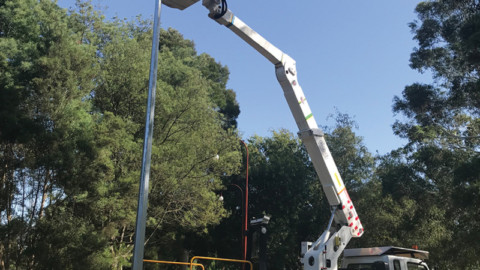Corrosion can have significant economic, structural and performance impacts on critical infrastructure across numerous sectors. Understanding its impact and knowing how to prevent it is an essential part of an organisation’s asset management strategy. A panel discussion at the Asset Management for Critical Infrastructure 2018 Conference in Sydney, looked at the importance of design criteria and material selection in preventing corrosion.
One of the highlights from the conference was a dedicated stream on corrosion featuring a panel of Australasian Corrosion Association (ACA) experts. Much of the dialogue from this panel centred around the need to build corrosion protection and management into a project at the design stage.

Jim Hickey, Electrolysis Engineering Officer, Network Test and Measurement at Ausgrid
“We need to get it right at the design stage. So once the design has considered the effects of corrosion, then the asset management plan can implement the directions of what’s in the design,” Jim Hickey, Electrolysis Engineering Officer, Network Test and Measurement at Ausgrid, said.
“We also need to make sure we use qualified, competent staff to carry out the maintenance. If we try to outsource and contract out the responsibility of the maintenance, then without that control I think it can lead to unsatisfactory outcomes.”
Andrew Jones, Senior Asset Integrity Engineer at CNC Project Management, said that the other key thing was to make sure that you actually got what you had designed.
“I know that in some instances, on projects, the project team will go and try to save money by using some inferior product, which does not deliver the required outcome, causes long-term operations and maintenance issues, and has the potential to cost more money over time.
“So, they’ll think, ‘Oh, I’ve got this cheaper product, it does the same job,’ but it doesn’t at the end of the day. So, you create this massive problem for yourself if you don’t do it right.”
Ensuring quality control
Brad Dockrill, Director of Vinsi Partners Consulting Engineers, added that sometimes Project Managers will be working on some sort of KPI system, where there are bonuses related to money and the saving of money, which can negatively impact the project in terms of quality.
“Don’t just accept that what’s been put on the specification and drawings is what you’ve been provided with. You really need to understand the materials you’re playing with, and not just materials, but the quality of the material. Then you’ve at least got a chance to try to manage your asset appropriately within a budget.”
Simon Krismer, Principal Consultant at Krismer Consulting, also agreed that a key step in managing corrosion is quality control, something that he feels is often overlooked during that design/manufacture stage.
“The problem with corrosion is that if it happens, it doesn’t happen overnight. People see a bit of flaking paint, a little bit of rust and say ‘it’s not important, we’ve got other things to spend the budget on’.
“A spot repair at the time is going to be cheaper than letting it rust, letting that damage develop, letting it stand and then have a bigger issue to deal with down the track,” Mr Krismer said.

Andrew Jones, Senior Asset Integrity Engineer at CNC Project Management
Sourcing the correct materials for the job
Concerns around the quality of materials available and holding suppliers accountable also featured prominently in the discussion.
“If we look at stainless steel, say 316 for example, it should contain at least two per cent molybdenum, which gives you that pitting resistance and extra corrosion resistance. But let’s say you want to save costs by reducing the amount of molybdenum, because molybdenum is expensive, so you put in the absolute bare minimum. Maybe now you’re not quite getting the corrosion performance that you need,” Mr Krismer said.
“You can also have slight variations where sulphur and so on is a bit higher than it should be, on a real analysis. So there’s definite problems with the quality of materials, and traceability as well.”
Buying from overseas manufacturers can also come with its own set of problems.
“You might order a widget and you get something that has been cast to look exactly like that widget, but then you find out that it hasn’t been heat treated,” Mr Krismer said.
“It’s important to know what you’re getting and, from a design perspective, being very clear about what you’re ordering.
“So for example, you might need more than the right chemical composition, you might also need specific thermomechanical processing properties, heat treatment conditions or mechanical property criteria. It’s important to get to that granular level of detail, otherwise you don’t have a comeback.”
Improving the way assets are managed

Brad Dockrill, Director of Vinsi Partners Consulting Engineers
Mr Dockrill also touched on the use of ongoing preventative work to help prevent corrosion in older assets.
“I think there’s a short-term and a long-term approach, depending on your budgetary constraints. One short-term option would be using potable water to wash down your exposed steel structure to remove (or at least minimise) the salts.
“Afterwards, you can go and test for salts to establish when the next washing cycle is required, and you’re prolonging the life of the structure as is without spending a great deal of money. The long-term solution would be looking at protective coatings.”
For some organisations, engaging a corrosion expert to carry out a risk assessment and develop a management plan can offer them access to expertise and untapped resources that they might not have internally. A list of credible corrosion experts can be found through the Australasian Corrosion Association (ACA).
Mr Dockrill commented that while the development of new technologies and materials is essential to ensure continuous improvement in the way assets are managed, there is no ‘silver bullet’ solution.
“I think everyone wants the latest, greatest, iPhone type, new material, thinking it’s going to be the silver bullet solution, and it’s not. It’s not viable to build all our assets out of carbon fibre or graphene, or whatever the latest wonder material is, you need to look at what materials are best suited to your design purpose, the specific environmental conditions and your operational constraints.”
Getting it right at the start

Simon Krismer, Principal Consultant at Krismer Consulting
Mr Krismer said organisations who are aware of the potential for corrosion and the effect it’ll have on their asset management and maintenance costs understand that the cheapest option isn’t always the best option.
“Sometimes spending a few extra dollars on the right paint specification, the right preparation, quality control, etc will prevent so many issues down the track, and then you actually know that your asset is going to be pretty much trouble free for a known period of time. Then you need appropriate maintenance strategies and inspection plans, and to be able to tie it into the overarching asset management plan.
“Corrosion is one of those things which just flies under the radar, and no one really gives it due consideration, except in exceedingly high-risk industries like pipelines where you make front page news when it does go wrong. Corrosion does permeate all aspects though, and I don’t really know any infrastructure which is not susceptible to corrosion in one way or another.”

















